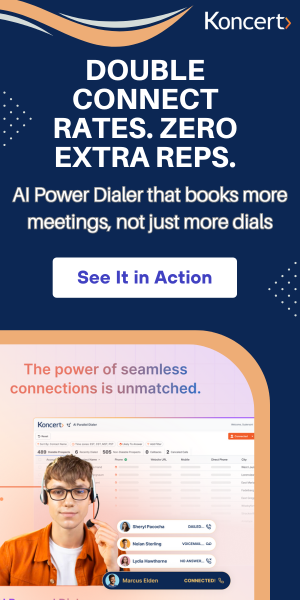
Everything needs a plan. Instead of sitting down and calling, it’s important you develop an outbound sales cadence that makes sense for your team and your prospects. Make sure your team is following through by making it realistic. Here’s a little bit more on what an outbound sales cadence is and the best ways to set yours up.
What is outbound sales cadence?
Outbound sales cadence is how often you reach out to your prospects via phone, email, or text. The cadence begins with the first contact attempt and continues throughout a sequence of steps until the prospect exits the cadence and is sent to marketing for nurturing or converts to a sales opportunity. The schedule ensures that reps reach out to prospects enough time in a diversified manner to start meaningful conversations and ultimately get the sale.
Learn sales outreach best practices. Read this blog.
Your leads are busy. And they respond based on convenience. They’ll pick up the phone if they have a moment, and they’ll respond to an email or click on a message if it catches their eye. Therefore, in your organization, the sales cadence should include several channels to connect with prospects including social media, person-to-person meetings, phone calls, email, or all these. Every message in your outbound sales cadence should reinforce the previous one, creating moments where the lead can exit the cadence and enter the sales cycle.
The sales cadence drives the necessary steps to move leads through the sales funnel.
Why Do You Need a Sales Cadence?
It’s difficult to understand prospect responses without metrics for comparison. If each prospect receives a different experience when they inquire about your product or service, how do you improve your success rate?
By creating a cadence, you put everyone on the same calendar, experiencing the same type of contacts. Everyone gets a unified message. Then you can compare metrics from all of the prospects to see what works and what doesn't work. You can also automate touchpoints with prospects to preserve momentum and velocity. While every industry may have unique cadences and channels to reach prospects, the concept of an outbound sales cadence stays the same.
It takes 7 to 10 attempts to establish contact with a prospect. A cadence manages all those steps, ensuring that no leads get left behind and injects momentum and velocity into the sales cycle.
How Do You Create an Outbound Sales Cadence that Converts?
Pair Calls and Emails
Pairing calls and emails is more effective than either one alone. For instance, your outbound sales cadence can have emails that share educational materials that are valuable to your prospects.
While you can’t tell if a prospect listened to your voicemail, you could see if they’ve opened an email or interacted with the content. Reps can see when a message was sent and follow up appropriately. Reps can also track email opens or form files. Having the ability to know this and pick up the phone gives more power to the sales team.
SMS Text Messaging
Text messaging is becoming a popular method of sending a quick message in B2B sales. In fact, 98 percent of all texts are opened as opposed to only 22 percent of emails. Texts are ideal for follow-up.
Don’t send information about why your product is so great. That can look like spam. Instead, use texts to confirm meetings or clarify a quick question. You’ll likely get a faster response than an email.
Ask for permission or an opt-in for text messaging when you reach them by phone or email before you send the first text. Otherwise, your texts might be unwelcomed and leave a bad taste in their mouth.
Automated Tools
Automated tools can help you schedule calls and emails, track progress, and reduce the time you spend on manual data entry. A tool such as Koncert allows sales reps to use templates for follow-up emails in a personalized manner while saving time for other more critical activities. You can spend more time talking to customers and less time in front of a computer. Yet you will still be able to stay in touch in a timely manner with a personalized email.
Optimization
Once you set up the sales cadence, you can't just walk away. It's important to monitor your sales team’s success. Which touchpoints or assets result in a lead taking a meeting? As you gain data, it’s important to tweak your cadence.
If emails aren't opened, you might need to alter the subject line. Or if prospects are unavailable during certain hours during the day, change the time for calling. As you accumulate information about your prospects, plug that info into your sales cadence. You will be able to use that information for more meaningful relationship building.
Don't forget to find out which channel is your prospect's preferred method of connecting. Listen to your prospects to determine their needs.
The more information you have on how your prospects interact with your sales cadence, the more you’ll be able to perfect the process.
Non-stop calling and non-stop emailing is not the answer. Create a strategic outbound sales cadence that your sales team will thank you for. Koncert's Cadence software can help you develop the perfect outbound sales cadence for your organization.
Related Posts
10 min read
High-Quality Outreach - Why Koncert's ZigZag Dialing® Replaces Call Blasting
Dec 12, 2025 by Koncert Marketing
13 min read
7 Outbound Sales Trends for 2026 - AI, Latency, & Max Connect
Dec 4, 2025 by Koncert Marketing


